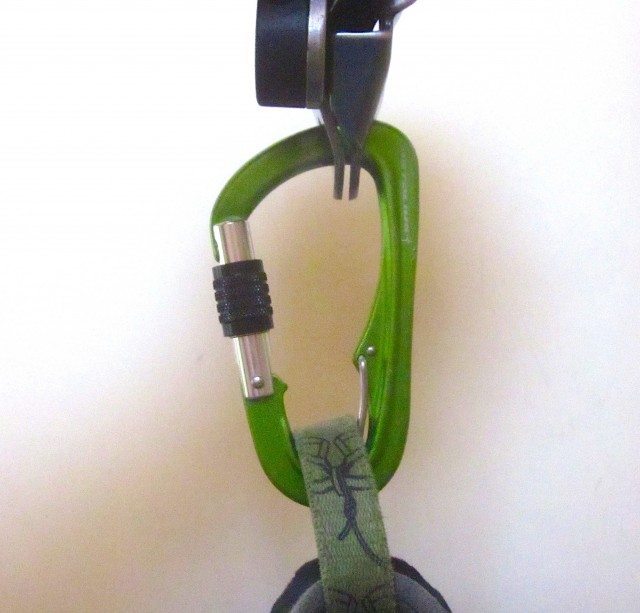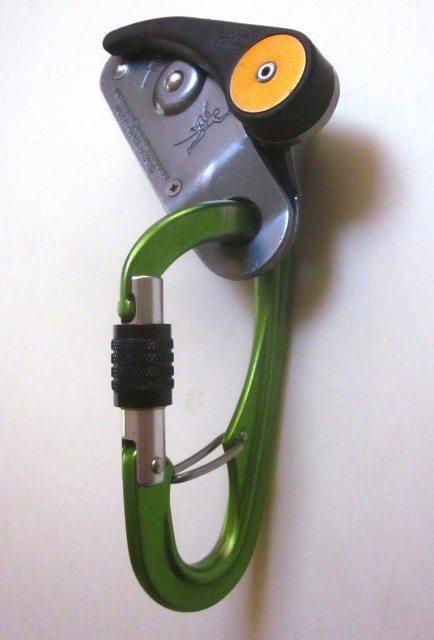
Metolius Gatekeeper Belay Carabiner
Strength:
Major axis: 22kN
Gate open: 7kN
Minor axis: 7kN
Weight: 70g
MSRP: $18
Time tested: 2 months
Locations: Clear Creek Canyon, Eldorado Canyon, Rocky Mountain National Park
Metolius introduced the Gatekeeper this year, joining companies such as Black Diamond, CAMP, Rock Exotica, and DMM in offering a cross-load-proof belay carabiner.
The Gatekeeper uses certain design features—most notably a wire gate that partitions off the narrow bottom of the carabiner—to prevent the carabiner from rotating sideways during normal belay or rappel movements.
These features eliminate the possibility of “cross-loading” the carabiner (the industry term for loading a carabiner on its relatively weak minor axis), a dangerous situation should the climber fall while the carabiner is sideways.
Before getting into the utility of this concept, let’s take a closer look at the Gatekeeper, then step back to consider when it might be useful to you as a climber.
Wire Gate
To start with the obvious, the Gatekeeper has a spring-loaded wire gate—much like those on regular wire-gate carabiners—at its base that you snap your belay loop into. This is the primary mechanism that constrains the rope while belaying.
It’s an effective tool for keeping the carabiner properly oriented. I haven’t been able to find any design weaknesses even while playing around with it. You have to intentionally open the wire gate to release your belay loop.
This mechanism is an improvement on the anti-cross-loading design of the Black Diamond Gridlock. Because of the Gridlock’s shape, it’s possible for a grigri to migrate along the spine of the carabiner. (This is examined in greater detail in Hannah Trim’s review of the Gridlock.) The Gatekeeper eliminates this problem.
My one admittedly minor gripe is that I wish the wire gate was either slightly higher (closer to the center of the carabiner), or that the space below the gate was a little deeper. When loading a belay device onto the carabiner and putting the ‘biner on my belay loop, I want to simply pull outward to open the gate and allow the belay loop to slide down to the base of the carabiner. The gate should snap closed behind it.

This only happens about half the time. The rest of the time my belay loop doesn’t move far enough to let the wire gate close, so I have to wiggle the carabiner around or close it by hand.
This would be an easy fix (and again, it’s a minor issue), but given the $18 price tag, it’s something that I’d like to see Metolius address in subsequent generations.
For the sake of reference, I’ve been climbing in a Petzl Corax harness. One of my climbing partners uses a Mammut harness and doesn’t have this problem, so this may not be an issue for you depending on your harness.
Spine
The Gatekeeper’s spine is also designed to prevent cross-loading. It widens as you move toward the ‘biner’s apex—the point furthest from your body when the carabiner is attached to your harness while belaying. This is a clever but subtle design element that you might not notice at first glance.
The spine widens just enough to prevent assisted braking devices (grigri, cinch, etc.) from sliding into a position where cross-loading is possible. Because of the large retaining loops on ATC-type devices, this obviously doesn’t come into play when using those devices, but it works well for grigris.

Locking Barrel
The last noteworthy feature is the barrel that locks the gate. Since the barrel has a long track and overlaps with the gate, it has to travel further before clearing the gate. Presumably this makes the carabiner less likely to unlock by accident. This is a nice idea, but I’ve admittedly never had a lock accidentally open while belaying.
The Issue of Cross-Loading
This brings us back to a more general point about these types of ‘biners. The Gatekeeper is very well designed to prevent cross-loading and the elements that stabilize the carabiner’s orientation are robust and secure.
But I’m not convinced that these belay carabiners solve problems that need solving. The problem of cross-loading a belay carabiner can be avoided by tending to your belay, something you should be doing anyway. Perhaps the Gatekeeper can be used to teach beginners who are overwhelmed by the number of things they have to attend to.
It should be pointed out that cross-loading a carabiner should be avoided since the minor axis of these larger lockers is dramatically weaker than the major axis (7 or 8kN vs. 22-24kN with a closed gate). However, even 7 or 8kN is way more force than you should experience as a belayer. If you’re knocking on the door of 7 or 8kN as a belayer, you’ve got bigger problems than a few bells and whistles on a carabiner can solve.
Some might say accidents do happen even when you’re paying attention, and an extra measure of safety doesn’t hurt. That’s valid. The only problem with the belay-specific carabiner is that it’s less versatile for use in other areas. It works fine for multi-pitch routes and belaying directly off an anchor, but the wire gate at the bottom adds an extra step to the transfer from harness to anchor (or belay loop to gear loop) and back.
Additionally, the asymmetrical shape of the spine restricts the Gatekeeper’s uses, (God forbid you drop your belay device and have to belay or rappel with a munter hitch…).
So while the Gatekeeper is a home run for belay security and cross-loading prevention, it comes at a cost, and that specific cost depends on what sort of climbing you do. If you climb in the gym or at the crag, you’re likely won’t be bothered by these issues.
Ultimately, the value of the Gatekeeper will be determined by the extent to which you accept the premise that you need to do everything you can to avoid cross-loading a belay carabiner. I took it out both at the crag and on longer trad days. I liked using it at the gym or when sport climbing, but I eventually found myself reaching for a standard rounded locker on multi-pitch routes.
Bottom Line
If you’re a single-pitch sport/gym climber and will likely never take your belay device off its carabiner, the Gatekeeper is a great option. Relative to its peers (the Black Diamond Gridlock, Rock Exotica Pirate Wire-eye, etc.) the Gatekeeper is light, effective, and has a low profile.
But if you’re a multi-pitch trad climber, or put a premium on versatility in your carabiners, you’re not going to like the Gatekeeper nearly as much as even garden-variety lockers.
